The UECNA is run on what might be described as a ‘Bishop in Synod’ or a ‘Bishop in Presbytery’ system where the duties of governance are shared. This echoes some aspects of Ussher’s plan for a moderated Episcopacy, which was proposed during the run-up to the English Civil War, but its more specific context is William White’s The Case of the Episcopal Church in the United States Considered (1782.) White proposed creating State and Federal Conventions, consisting of clergy and laity, to administer the Church, over which would be elected a presiding officer, who would undertake the functions of a bishop until such time as the historic episcopate could be secured from England. The State Conventions started meeting in 1783, and the first General Convention was held in 1785.
At this stage, the Conventions were unicameral, with the clergy and laity sitting and deliberating together, and this was only modified in 1789 to encourage and facilitate Bishop Seabury’s participation in the General Convention. With various small adjustments, the bishop and convention model at state/diocesan and federal level has continued until this day. Its intention is to make the government of the church cooperative and consultative, rather than a straightforward monarchical system.
In broad terms, the Diocesan Convocation or Convention, and General Convention decide the broad outlines of policy, set the budget, and address local and national concerns. They also elect the Standing Committee and the National Council, which act as permanent consultative bodies to the bishop(s) between the meetings of the various synods. In some ways, it is the bishop in consultation with the standing committee which is the backbone of diocesan administration. For example, the standing committee approves candidates for ordination and grants permanent Canonical Residence to clergy. It is also consulted in connection with some disciplinary issues, and when there is no resident bishop, it acts as the ‘Ordinary’ of the diocese.
The Bishop, on the other hand, can trace his origins back to the New Testament, and, in accepting the 1662 Preface to the Ordinal, the UECNA is committed to the view that bishops constitute an order distinct from the presbyters in the Church. This was a ‘push back’ against the Presbyterian claims concerning the parity of ministers–an issue that was all too relevant in the aftermath of the English Civil War. The bishop’s duties are to celebrate the sacraments and to preach the word of God (which are functions he shares with the presbyterate), to administer the discipline of the Church (which he starts with the Ecclesiastical Courts) and to act as Guardian of the Faith, to confirm, and to ordain. In administration and ordination, he is expected to consult with the Standing Committee of the diocese, but it must be understood that the clergy owe Canonical Obedience to the bishop, and, if the bishop’s directions are in accordance with the Canons of the Church, follow his direction.
On the whole, the sort of Bishop-in-Synod government practiced in the UECNA works well if all those who participate in it–bishops, clergy, and laity–understand their duties and responsibilities. It is not a democratic system but, rather, a representative system which allows for a broad range of voices to be heard in the administration of the Church. There is, however, one area in which the Bishops and Synods have no discretion, and that is doctrine. The doctrine of the UECNA is based upon the Holy Scriptures, the three ancient Creeds, and the Ecumenical Councils, as interpreted through the Articles of Religion, the Homilies, and the Prayer Book.

Presiding bishop of the United Episcopal Church of North America, bishop of the Missionary Diocese of the East, and rector of Good Shepherd Anglican Church in Waynesboro, Virginia.

